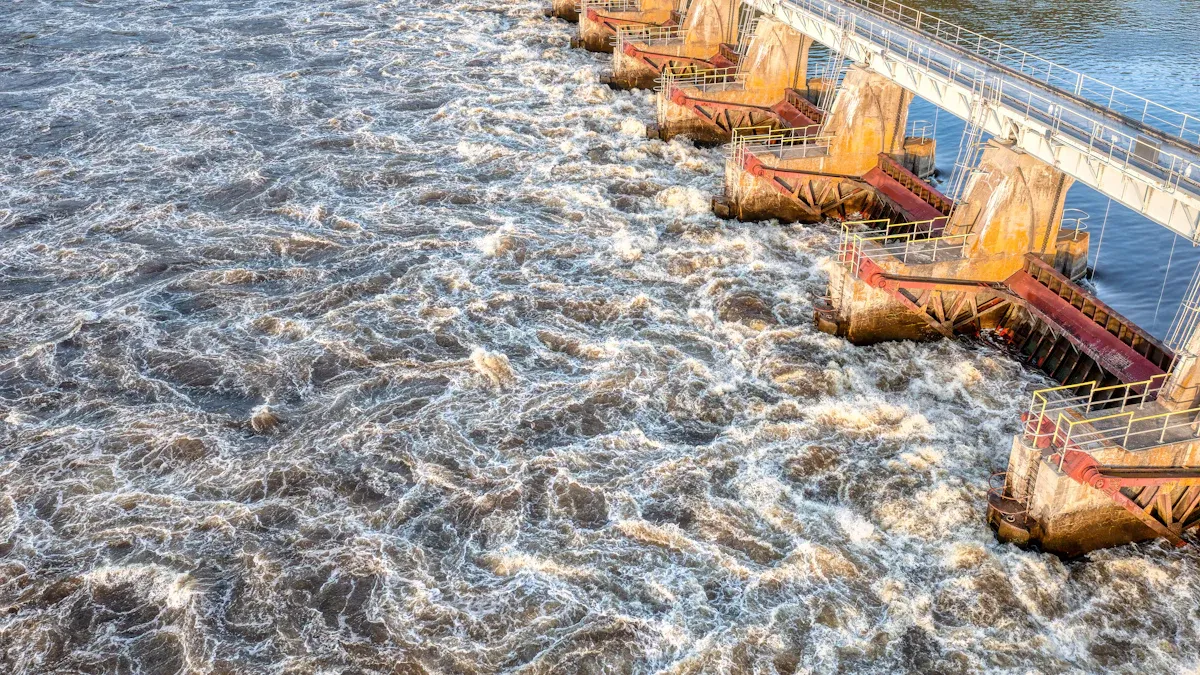
You can help your team be more creative by using Taoism flow. When you use taoist principles, you bring a natural rhythm to brainstorming. Taoism tells you to focus on now and let ideas come without pushing. Many teams see that taoist principles help them notice progress, think about their growth, and find new ways to be creative in business.
-
Teams who use taoist principles often:
Stay calm and patient when doing creative work
Care more about good work than fast work
Like working together and thinking in new ways
Key Takeaways
Use Taoist flow by letting ideas come on their own. Do not force ideas. This helps boost creativity.
Balance clear goals with freedom for new ideas. This helps your team work well. It also helps them stay creative.
Make a safe space where everyone can share ideas. People should feel safe and respected.
Let go of control and trust your team. Let them try new solutions. Let them handle surprises.
Build trust by listening to your team. Show kindness to help your team grow. This helps everyone work better together.
Team Creativity

Wu Wei Explained
You can help your team be creative by learning about Wu Wei. Wu Wei is a Taoist idea. It means doing things without forcing them. You let ideas and answers come on their own. When your team uses Wu Wei, work feels less stressful. People feel more relaxed and open. Team members feel safe to share their thoughts. Wu Wei helps you trust your team and the way you work. You step back and let everyone use what they are good at. This makes it easier for your team to work together and be creative. The Tao Te Ching says to act in harmony with nature. When your team does this, teamwork gets better and work feels easier. You do not have to control everything. You let your team grow and find new ideas together.
Taoist Principles for Teams
Taoist principles help teams work well together and get along. Taoism teaches about balance, kindness, and working in harmony. These ideas help everyone feel respected at work. When you mix different skills and personalities, your team gets more creative. The Tao Te Ching says to balance action and rest. You can see this when your team shares ideas. Sometimes you need rules, but you also need time for new ideas to pop up. Wu Wei lets your team move forward without feeling rushed. Teamwork feels better and people want to share more. The Tao Te Ching also says to be kind and thankful. When your team uses these Taoist ideas, you see more creativity and better teamwork. People are happier and work together well. Your team becomes more creative when you trust the process and let ideas come naturally.
Embracing Change in Brainstorming

Openness to New Ideas
When you begin brainstorming, being open to change is important. You help your team by making a safe place to share ideas. No one judges or ignores any ideas. This helps your team look for new and creative answers. When people feel free, they share more ideas. You see more different and creative thoughts.
Tip: Tell your team that all ideas are welcome in brainstorming. Ask everyone to add to each other's ideas.
You can help your team by making sure everyone talks. You do not let one person talk the whole time. You use things like taking turns or drawing ideas to keep sharing fair. This stops groupthink and helps your team find new ideas. You also check if everyone is sharing and if there are many kinds of ideas.
You support openness by helping your team connect at work and outside. When people feel close, they share more and try new things. You keep things positive and friendly, so everyone wants to join in. You also talk about ideas later, so your team knows their ideas matter.
Letting Go of Control
Letting go of control is a big Taoist principle. You let ideas come on their own. You do not force results or follow a strict plan. You trust your team to find good answers together. This helps your team handle surprises and try new things.
You plan workshops with open talks and free sharing. You start with a big question and let the talk grow. Ideas can go in many ways. Later, your team will see patterns and connect ideas. This feels easy and helps your team work well.
-
Try these steps in your next meeting:
Start with a big question.
Let everyone talk without stopping them.
Let ideas grow and connect.
Look for times when ideas fit together.
Studies show teams with more freedom are more creative. When you let go of control, your team feels trusted. They want to try new things and take risks. You help your team see surprises as good. This keeps your team working well and helps ideas flow.
You also see that change means things are not always planned. You do not always know what will happen. You trust your team and the process. This trust makes your team stronger and helps everyone feel important.
Note: Letting things be open does not mean things get wild. You still help guide the group and keep ideas moving.
By being open, letting go of control, and accepting change, you help your team be more creative. You make a place where ideas can grow, your team works well, and everyone feels part of the creative process.
Principle of Balance
Structure vs. Spontaneity
You help your team grow when you find the right mix of structure and spontaneity. The principle of balance means you do not let one side take over. You set clear goals for your team, but you also give space for ideas to flow. This dynamic balance lets your team enjoy both order and freedom.
When you use the principle of balance, you start with a plan. You might use an agenda or set a big question for your team. Then, you let everyone share ideas in their own way. Some teams use individual brainstorming before group talks. This helps everyone think for themselves and stops early groupthink. A Brazilian aviation company used this method. They mixed clear objectives with free idea sharing. Their team found more creative answers and solved problems together. They saw that the quality of ideas mattered more than the number. The team felt more creative and worked in natural harmony.
You can try these steps with your team:
Set a clear goal for the session.
Let each person write down ideas alone.
Share ideas as a group.
Look for patterns and connections.
Let the team decide when to move forward.
Teams that use the principle of balance report better collaboration and more trust. They say that structure helps them stay on track, while flexibility lets new ideas appear. You see more compassion and empathy in these teams. People listen to each other and respect different views. This approach supports fostering harmony and helps your team reach natural harmony.
Tip: Remind your team that both structure and flexibility are important. You do not have to choose one over the other.
Gentle Facilitation
Gentle facilitation means you guide your team without taking control. You use the principle of balance to help everyone feel safe and included. You do not push your team too hard. Instead, you use compassion and empathy to support each person.
You can use different ways to help your team share. Try calling on people in a random order or use a round-robin. Invite volunteers or ask quiet members to join in. These methods help everyone feel part of the team. You can also use reflective pauses. Give your team a moment to think before they answer. This helps people share thoughtful ideas and keeps the mood calm.
A good facilitator acts like a navigation app. You adjust your path as the team moves forward. You do not force the team to follow one way. You help the team find its own path to natural harmony. You also let your team know it is okay to make mistakes. This right to be wrong builds trust and helps ideas grow.
Teams that use gentle facilitation say they feel more open and creative. They report stronger compassion and empathy. They also say that regular, well-structured sessions with flexibility help them improve. Your team will feel safe to try new things and learn from each other.
Note: Training in Taoist-inspired brainstorming teaches you to notice the energy in the room. You learn to support your team with mindfulness and kindness. This helps you guide the team with a light touch and keep the principle of balance.
When you use the principle of balance, you help your team find natural harmony. You support creativity, trust, and growth. Your team learns to work together with compassion and flexibility.
Overcoming Challenges with Taoist Principles
Addressing Resistance
You may notice that some team members feel unsure when you try new ways of working. Fear of uncertainty or a reluctance to let go of control can slow down progress. Taoist principles help you guide your team through these feelings. You can start by showing compassion and understanding. Remind your team that change is natural and can lead to growth. Encourage everyone to practice active listening. When you listen closely, you show respect for each idea. This helps your team feel safe to share their thoughts.
You can create a supportive environment by inviting everyone to speak. Use active listening to make sure each voice matters. When your team feels heard, they become more open to new ideas. You can also share stories of other teams who have adapted Taoist ideas. For example, some companies let managers change roles naturally. This reduces stress and helps the team become more creative. When you allow your team to adapt, you see more trust and better results.
Building Trust
Trust grows when you treat each team member as important. Taoist principles teach you to value every person. No one can succeed alone. Your team needs each member to reach its goals. You can build trust by showing fairness and respect. Use active listening in every meeting. This helps your team feel valued and included.
A supportive environment makes it easier for your team to work together. When you show compassion, your team feels safe to take risks. Research shows that teams with trust and respect unlock more creativity. You can hold regular talks where your team shares what went well and what can improve. This helps everyone learn and grow together.
When you use Taoist principles, your team learns to adapt to change. You see more harmony, better teamwork, and a stronger sense of belonging. Your team becomes ready to face any challenge with confidence.
When you use Taoist flow with your team, everyone can grow together. You will see more creative ideas and people feel less stressed. Teams that follow these ideas often notice these things:
Leaders help everyone join in and let people take charge.
People feel safe to talk and learn from each other.
The team can change easily and cares about balance and kindness.
Try using these Taoist principles in your next meeting. You might find new strengths and have a happier, more creative team. 🌱
FAQ
What is Taoist flow in teamwork?
Taoist flow means letting ideas come naturally. You do not force results. You trust your team and let everyone share. This helps your team feel relaxed and creative.
How can I start using Taoist principles in meetings?
Try starting with an open question. Let everyone speak without judging ideas. Allow the conversation to grow. You will see more creative thoughts appear.
Why does letting go of control help creativity?
When you let go of control, your team feels safe. People share more ideas. You see new solutions. Creativity grows because everyone feels trusted.
Can Taoist flow work for any team?
Yes! Any team can use Taoist flow. You only need to stay open, listen, and trust the process. Teams of all sizes and types can benefit.






